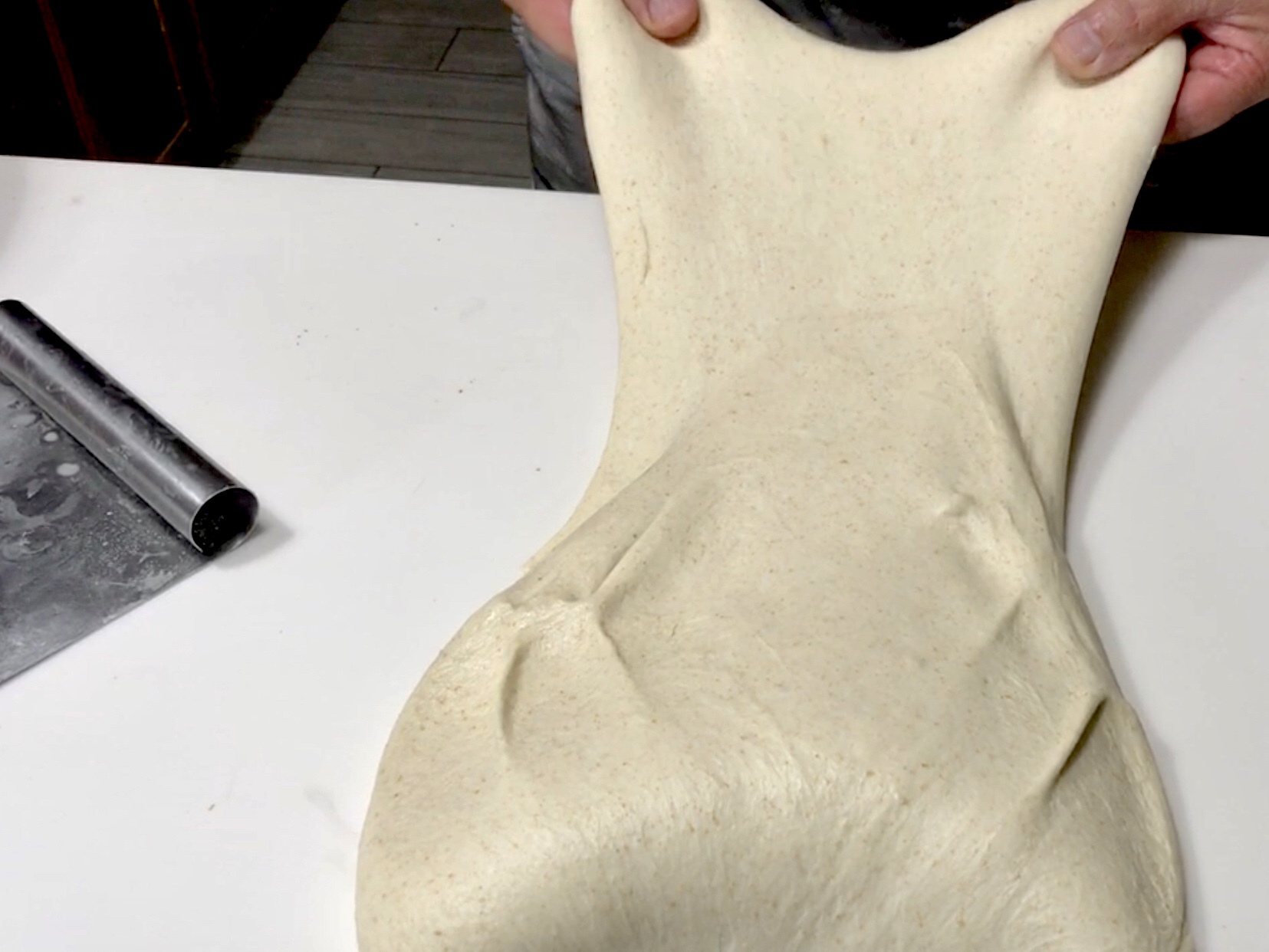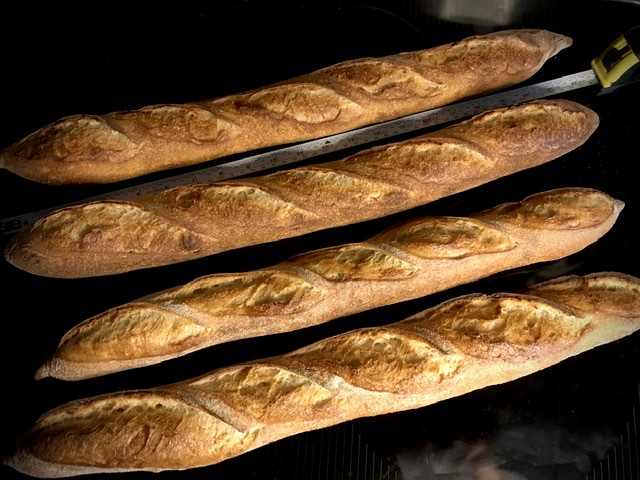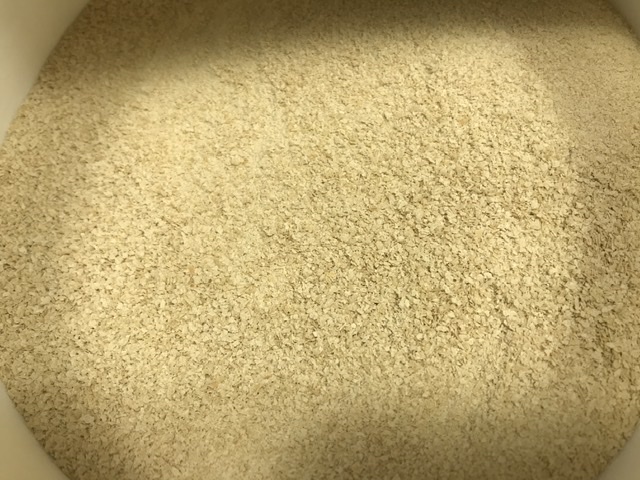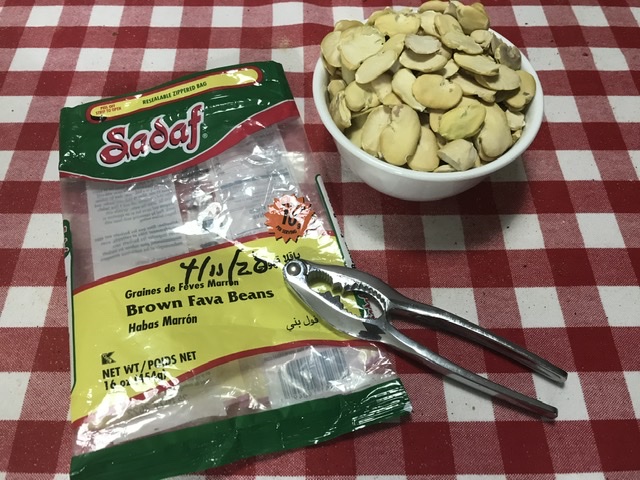
Lance, aka Albacore sent me THIS LINK after a discussion about increasing extensibility of bread dough. My mantra, "I'll try most things once" kicked in.
The baker in the Instagram video used 4% Nutritional Yeast and 4% Fava Beans. I wasn't that brave so opted for 2% of each. What a phenomenal difference! I used the formula recommended by Alfanso for the Baguette Community Bake. It calls for 68% hydration and that is what was used. The short video below shows an extremely extensible dough that hopefully will enhance the shaping of baguettes. Keep in mind, in no way was this dough stretched to it’s limits. I am new to this ingredient and didn’t want to push it.
Later handling of doughs with Nutritional Yeast reveals the following.
- it flavors the dough (you may or may not like that, I do)
- the dough doesn’t shrink back like normally expected during the shaping process
- the length of the baguette does not shorten during the bake
- amounts probably should be adjusted downward (needs more testing). Ditto for the Fava Bean.
The short video is best viewed using THIS LINK.
Ta-daaaah!


Nutritional Yeast on left, Fava Beans on right.
Danny
This is such a coincidence, I just picked up nutritional yeast yesterday and was reading about its effect on gluten. I didn’t buy it for that, but instead to season vegetarian meals with cheesey nutty flavour.
Doc mentioned this yesterday, the day after my Nutritional yeast came in.
http://www.thefreshloaf.com/node/64622/community-bake-baguettes-alfanso?page=1#comment-462120
Maybe the stars are aligning...
Hey Benny, your latest baguettes are stellar.
It’s beginning to look like your PhD is in sourdough.
NOTE - I’m not sure if the Fava Beans are necessary. I wouldn’t hesitate to try 2% NY.
That’s kind of you to say Dan, but I certainly need much more practice, my shaping of the baguettes was far from consistent. But I have to admit that I am enjoying baking them.
Never used or even heard of nutritional yeast prior to the CB thread. kendalm is a believer of garbanzo bean or fava bean flours.
And I can't argue with the way that the dough here is demonstrable proof of the value of the "dough enhancers". However, there are more ways than one to skin a cat.
Here is the IDY based 100% AP Bouabasa baguette dough at 75% hydration during its first stretch and fold after a 20 minute rest.
Here is the Levain based 90% AP Maurizio baguette dough at 73% hydration during its first stretch and fold after a 30 minute rest.
Both of these are higher hydration doughs than yours is, but the natural extensibility of both is quite evident without any added ingredients. Adding the nutritional yeast and fava bean flour to these two doughs might create something so extensible as to render them unwieldy.
I guess what it comes down to is to experiment, as you are doing here. And - most importantly - get to know your dough.
Very nice dough in linked videos, Alan. Super extensible, for sure. But can you do it at 68% using some whole grain? I think that may become the benefit of these natural ingredients.
But more testing and more experience is needed.
wouldn't be the same, but it is pretty darned extensible. I'll report back on the next batch. Stay tuna-ed.
And as mentioned, we all need to get to know our doughs. Clearly, first time out of the chute, we don't know what we'll find for sure. But by iterative bakes, we should be more clear on what we can and can't do.
Alan, if can produce highly extensible dough with Hamelman’s formula, please let me know.
I’ve baked that formula 3 or 4 times now. Towards the end of the slap and folds the dough is so tight, a strong coil fold is about all I can get. Using KAAP.
Fava bean flour is used for its lipoxygenase enzymes, which are an oxidising agent. While Glutathione (glu-ta-thigh-own) is a common reducing agent.
Oxidising agents are used to strengthen the dough and provide more elasticity while reducing agents are used to make a dough more slack and extensible.
EDIT: Also the lipoxygenase is a bleaching agent too unlike ascorbic acid which only strengthens the gluten network.
Michael, are they working against each? It seems like they may be at odds against one another.
I tried Fava Beans without Nutritional Yeast and wasn’t impressed. But the Nutritional Yeast by itself or coupled with Fava (don’t know which) is very powerful at increasing extensibility in my limited experience.
From your description, “ Oxidising agents are used to strengthen the dough and provide more elasticity”, it seems Fava may be very useful for my extremely long (17.5 hr) and warm (78F) ferment for Sanfrancisco Sourdough. Ascorbic Acid has helped n the past.
Let me ask another. “ Also the lipoxygenase is a bleaching agent too unlike ascorbic acid”. Does this type of “bleaching action” affect the flavor of the bread?
Thanks for taking the time to home school me...
but actually no it's not that simple. Different agents do different things and they do them in different ways. It's not uncommon for commercial plant bakeries to add both reducing agents and oxidisers to their dough. I realised long ago that boosting the performance of dough should be seen as a balancing act. Elasticity encompasses both resistance and extensibility and favouring one too much over the other decreases performance.
Oxidisers alone increase resistance and reduce extensibility but allow for greater gas retention and therefore a protentional for greater volume. But to realise that volume you need extensibility to take your dough to that distance. And in commercial bakeries by using both they can reduce the mixing time.
Think of it this way, oxidisers advance the development of gluten (oxidation helps to create polymers and strong disulphide bonds) but reducing agents provide that extra extensibility as if it were mixed at a higher hydration without actually being so.
Yes I believe that the bleaching lipoxygenase would have an affect on flavour.
Up until this last bake (used NY & Fava) baguettes were not my bag. But this latest bake changed me forever...
The crust is crispy and requires a little bite. The crumb is soft, and the two very different textures are undeniably superior together. Unlike other baguette bakes, this one was pleasantly sour in a smooth, lactic way.
I need to document this bake before it is lost to me forever. I will be supremely distraught if the bake can not be duplicated.
Dan, please make a blog post, or forum post, out of the formula, pics and all, so it can be easily linked to, and folks won't have to scroll through the zillion comments onthe CB. Thx.
You juuuuust might get me to dare attempt making baguettes.
(*Hawaii 5-O reference.)
Dave, the bake in it's entirety is posted here.
http://www.thefreshloaf.com/node/64622/community-bake-baguettes-alfanso?page=1#comment-462465
If the bake can be duplicated, I'll post a link on my BLOG. I really hope this wasn't a fluke...
Dave come on in, the water’s just right.
Dan, i mentioned to you that I'd get a video of a S&F of the Hamelman pain au levain w/WW to demonstrate that there is significant extensibility. Well, this morning the wife asked if I could put together a focaccia pronto. Or sooner.
I decided on the Vermont SD as I had plenty of 100% levain in the back of the refrigerator, it having been refreshed about a week ago. The particulars:
Hamelman Vermont SD dough. 65% hydration, 90% AP flour, 10% rye, 100% hydration AP levain. This is the first Letter Fold/Stretch & Fold 50 minutes after hand mixing. 300 French Folds and a 50 minute rest before the video was taken.
The question I have is why is my dough so extensible, even at 65% hydration, and a number of folks had issues at 68% in the CB? The flour is as common as can be a 50/50 blend of Walmart AP unbleached and Gold Medal Bread Flours. Tap water, Kosher salt. Clearly nothing fancy.
If there was a point to be made, it is that extensibility is not just the domain of high hydration doughs.
I guess the flour makes the difference. Towards the end of your 300 FF is the dough still stretching as itnismslaped down?
wished I would have made a video also. Mixed up another batch today. I struggled with the first 100 FF then rested it 20 minutes. Came back and and after 15-20 FF gave up because the dough was way too elastic. May mix another batch tomorrow. I may go 70%. After about 7 bakes using your formula, my dough looks nothing like yours. Used KAAP and also Morbread flour.
The dough was more resistant than this for sure during FFs. My M.O. for this dough, and most, is to mix the levain in water, add flour (and in this case salt) pinch and fold to get hydration underway and then a 20 min autolyse before FFs.
Sure he dough was "tighter" during FFs, but not like what some folks, like you, have experienced. Again, this isn't the same formula, but close enough, and with a lower hydration.
I'm on the last vestiges of the flour mix that I bought, the only flours that I could find during the height of the toilet paper/flour/rice & pasta crisis. And even then I was lucky at that moment. Since then, things have returned mostly to normal, but for a few weeks, as most of us know, it was touch and go. And I was touching and going with whatever flour I could find!
The Walmart flour, is actually pretty nice to work with, and I wan't expecting much from a supermarket branded flour that sells for US$1.88 for 5 lbs. There's an advantage to being able to shop at codger hours right now!
I'll go back to my new store of KA AP next, and it will give me the same extensibility as this. I've been there.
Alan, after the dough rest it is extensible, but once it is worked a little, in the case of FF it quickly gets very tight.
I wonder if water could be making the difference. Our water is hard.
are quite comfortably extensible at shaping time. Now, since I have never shaped either of these to the rather full baguette length I don't know when it stops being extensible and fights back. I can only report on my personal experience.
And I'd guess that hard water is a factor at some level since it introduces compounds and minerals into the dough that wouldn't ordinarily be there. I've been fortunate that everywhere I've ever lived the water right out of the tap has been clean and not hard (does that make it soft water?) without the need for any filtration on my end.
As far as the dough being relaxed after the 50 minutes, sure. I was merely demonstrating that an additional dough enhancer isn't necessary, so far, in the doughs that I mix. And that is another reason why I am a proponent of the very gentle pre-shape. Give the dough time to relax after dividing before the final shape.
Again, I can only report on my personal experience.
I have been working with some strange to me flours because of the hoarding and disruptions. My guess going by the ingredients is the Walmart type flour is juiced more with dough enhancers and enzymes that make it loose and requiring less water to do the job. KAFAP is not enriched and has few other additives. Throw in the water that has even more variables than the flour. My 75 looks like your 68 and I am not talking about age or IQ here.
According to the U.S. FDA, a pound of enriched flour must have the following quantities of nutrients to qualify: 2.9 milligrams of thiamin, 1.8 milligrams of riboflavin, 24 milligrams of niacin, 0.7 milligrams of folic acid, and 20 milligrams of iron.
During the manufacturing process of flour, certain vitamins and nutrients are lost, including iron and B vitamins, folic acid, riboflavin, niacin, and thiamine. The term "enriching" means that the aforementioned lost nutrients are added back into the product.
I just checked and here is the full list of ingredients on the bag of Walmart enriched unbleached AP flour:
Looking these up I find
I do not know what the effect that enriching does, since it "merely" adds the vitamins back in. But during the critical scavenging days of April and May beggars couldn't be choosy.
That said, this isn't the first date that I've had with either the Vermont SD nor the P au L w/WW doughs. Far from it on both accounts. And although I have no proof other than my feeble memory to guide me, I cannot recall these doughs acting any differently than before when I was using KA AP or even before that when I was employing Pillsbury or Gold Medal AP flours alone.
With rare exceptions I've never found the Letter Fold portion of the BF to be anything other than pliable and extensible with pretty much any dough. Not much different than in the video on the first LF, although it was the first time that I ever pulled the dough out like that trying to replicate what Dan had done.
My blend of the two flours is nearing the end and I'll be back mainlining KA AP by the next bake.
This is the flour that takes less water and is sticky as all get out. Good flavor soft texture. It has those and more. I could use a little of that maturing agent myself.
It must not be law anymore because KAF does not enrich. I like the flour with the malt already in it though and maybe that is what is meant by the enzymes.
and KA, by choice, just doesn't enrich their flours. For those mills that decide to enrich, they then have to follow the law, which why our two flours have the same labeling for enrichment.
Anyway, that's my guess.
KA AP contains malted barley flour. KA WW does not
Alan, just for the heck of it I’ll try bottled spring water in tomorrow's mix. But I plan to up the hydration to 70% and use Nutritional Yeast but no Fava Beans.
I saw no difference by using spring water. Upped the hydration to 70%. After 30 FF the dough resisted quite a bite. Rested 20 minutes - dough still tight. I quite FF did a single lamination and commence uninterrupted BF. The plan with Sunday’s bake is shape cold and bake it up after a short proof. If the dough is slack, I may put in freezer 20 min or so to make slashing easier.
A very informative textbook... Charles A. Stear - Handbook of Breadmaking Technology (1995).
I've extracted pages which describe ascorbic acid and glutathione.
I tried to look for information regarding whether adding fava bean flour etc is allowed in French baking. I found this reference:
as “traditional bread” (loosely translated), and the law authorizes the following additional ingredients: “la farine de fève (2 %), la farine de soja (0,5 %) et la farine de malt de blé (0,3 %) (Décret “Balladur” N°93-1074 du 13 Septembre 1993, article 2.) The “farine de fève” is fava bean flour, aka broad bean flour, and the “farine de soja” is soy-bean flour.
Julia Child had the hardest time recreating authentic French baguettes with pure American bread flour, until she realized the secret was the weaker French flour with the additives that are there to strengthen the flour.
This page further defines the action & allowance for additives (using Google Translate):
Fava Bean Flour
Action : the bean flour accelerates the oxidation of the dough via an enzyme called Lipoxygenase which fixes the oxygen in the air during kneading. Oxygen has a bleaching power and acts directly on the pigments of the flour by promoting the whitening of the dough. This oxidation also distorts the taste of the bread.
It contributes in part to the increase in the volume of products thanks to the strengthening of the glutinous network.
Its incorporation is done only in the mill, the dosage is on average from 0.7 to 1% of the weight of the flour (maximum tolerated 2%)
Soy Flour
Action : like bean flour, soy flour tends to make the dough whiten due to the presence of the same enzyme (lipoxygenase) but in greater quantity. It is for this reason that its incorporation (in the mill exclusively) is done in smaller proportions (0.5% of the weight of the flour).
It also participates in strengthening the glutinous network and softens the dough thanks to its emulsifying properties .
====
Using 4% fava bean flour is probably too much.
The links are superb. The trivial is also very interesting. A great post...
BTW, I also tried to understand how nutritional yeast works and what is allowed amount in the dough.
And found this information about "Deactivated Yeast" from Lesaffre.
In this book, it mentions the dosage between 0.1 to 1% based on manufacture recommendation. On chapter 6, it also said that "... to improve dough extensibility. This is particularly interesting for the production of long shaped breads like baguettes or the production of laminated dough."
I mentioned that my next mix would once more be with my new supply of KA AP flour. Here are two videos, self-explanatory. Dan and some other claimed difficulty in performing FFs on the Hamelman Pain au Levain w/WW as posted by us for the CB.
I did buy some NY today to add 2% or 14g to the mix. No other changes to the formula. Here you can see the start and end of the FF mix.
Even knowing that there are distinct difference in flours, I am still surprised that some have trouble mixing using FFs.
It’s your flour!
Or....... it’s your water, or your scale is faulty, or you’re a magician, or your wife is sprinkling fairy dust around the house, OR.............?
I noticed to used 2% NY. Did that make a huge difference in the FF?